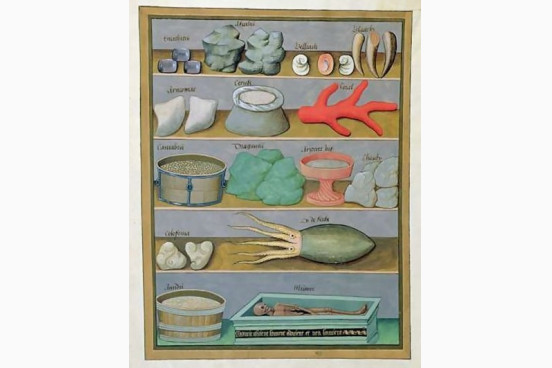The Saint Petersburg Book of Simple Medicines describes the medicinal properties of plants. It was made between 1487 and 1496 at Cognac in southwestern France for Charles d'Orléans, Count of Angoulême. Robinet Testard, who held an official appointment at Charles's court, expertly illuminated the manuscript. The text boasts a full-page author portrait and two quarter-page miniatures (fols. 4-110). A section of 116 pages of illustrations, primarily detailed renditions of the plants discussed in the early portion of the book, follows (fols. 112-169).
The manuscript's text is a French-language adaptation of Matthaeus Platearius's Latin-language Circa instans—an essential source of medical knowledge in the Middle Ages. The arrangement here, with the illustrations in a separate section, is unusual.
A Distinguished Career
Testard drew an annual salary to work as a painter for Charles of Angoulême, illuminating extraordinary manuscripts, including the Douce Roman de la Rose, the Hours of Charles of Angoulême, and the Secrets of the Natural World. After the count died in 1496, Testard continued to paint at court for Charles's widow, Louise of Savoy, and their son Francis I, King of France.
Naturalism for a Purpose
Testard's renditions of the plants appear before an unpainted parchment ground. They provide the necessary information to accurately identify the specimens in nature, including the root structure. This follows a long tradition in the illustration of herbals dating to the earliest surviving examples, such as the sixth-century Vienna Dioscorides.
Thematic Compositions
Testard's fully painted miniatures include compositions that highlight aspects of the circumstances of obtaining the curative substances. One of the quarter-page miniatures shows men using nets to collect aloe branches from a flowing stream (fol. 72v), and the other the mining of gold with a pickaxe and shovel (fol. 95v).
One of the full-page miniatures in the section of illustrations is devoted to orpiment (yellow arsenic), Armenian bol (an edible clay), and ambergris (a substance produced in the digestive system of sperm whales). In the upper register, the "gathering" of the substances is pictured, and each features a quotidian detail—a barrel for orpiment and a donkey for Armenian bol. In the lower register, a whale in the sea is a more straightforward representation of the "specimen" (fol. 143v).
A Mnemonic Image
A full-page image is devoted to "castoreum" (a substance extracted from the testicles of beavers) and "bedegar" (a growth on field roses). The miniature is dominated not by the dog-like beaver or the rose bush, both relegated to the background, but by an elegant woman with a unicorn in her lap in the foreground (fol. 163r). The unicorn, which could only be captured by a virgin, would bring to mind the beaver, also associated with virginity.
One Scribe and Two Annotators
A single scribe wrote the prose text and provided labels for the pictured plants in two columns in the formalized cursive script known as French Bâtard. In the sixteenth century, two medically knowledgeable scribes added annotations in Gothic Cursiva to the plant images.
In the Collection of the Holy Roman Emperor
The St. Petersburg manuscript is unfinished, perhaps due to the death of its patron in 1496. It was in the library of Charles V (1500-1558), Holy Roman Emperor, who signed it in three places (fols. 3, 71, and 111). It then found its way into the collection of Pierre Séguier (1588-1672). Séguier's grandson, Henri-Charles du Cambout (1664-1732), Duke of Coislin and bishop of Metz, donated it to the Benedictine abbey of Saint-Germain des Prés in Paris. Peter P. Dubrovsky (1754-1816) acquired the book from Saint-Germain in the late eighteenth century.
Alexander I (1777-1825), Emperor of Russia, purchased Dubrovsky's collection in 1805 for the Imperial Public Library. In the mid-nineteenth century, the Book of Simple Medicines was lent to the Hermitage for ten years. The Imperial Public Library was renamed the Russian Public Library in 1918, was known from 1932 to 1937 as the Saltykov-Shchedrin State Public Library and is now the National Library of Russia.
We have 1 facsimile edition of the manuscript "Saint Petersburg Book of Simple Medicines": Libro de los Medicamentos Simples facsimile edition, published by M. Moleiro Editor, 2000
Request Info / Price
